SEC S17-W3 || Onchain Metrics of Steem blockchain
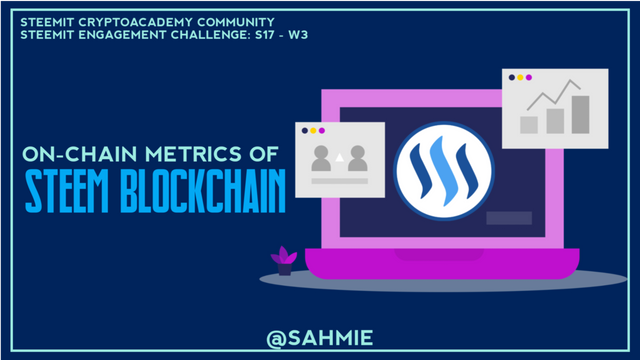 |
|---|
INTRODUCTION |
Steem On-chain metrics refer to the data and information that is recorded and stored on the Steem blockchain. We all know that Blockchain is like a digital ledger that keeps track of various activities, hence Steem Blockchain is like a digital ledger (record book) that keeps a record of all activities happening on the Steem platform, such as posts, comments, upvotes, and transfers of Steem cryptocurrency.
These metrics help us understand how active and engaged the Steem community is, as well as the popularity and impact of different content creators and they can also provide insights into the overall health and growth of the Steem network.
Therefore, this week our studies are centred around this record book that keeps track of everything happening on Steem, allowing us to analyze and measure the activity and interactions taking place within the platform.
What are the main On-chain Metrics indicators used to evaluate user activity on the Steem blockchain, and how can they be explained in terms of their significance? |
|---|
Several On-chain metrics on the Steem Blockchain keep records of different aspects of the platform such as account details, market information, system information, latest transactions, latest block, price and volume movements etc.
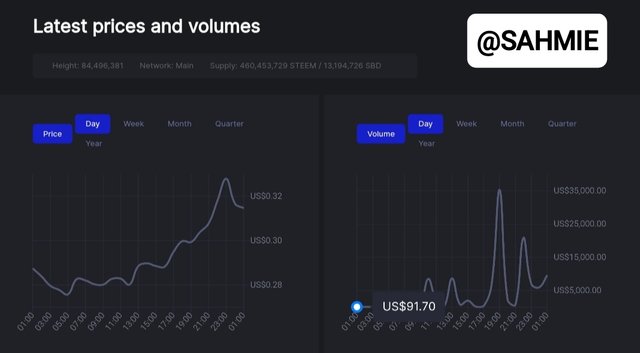 |
|---|
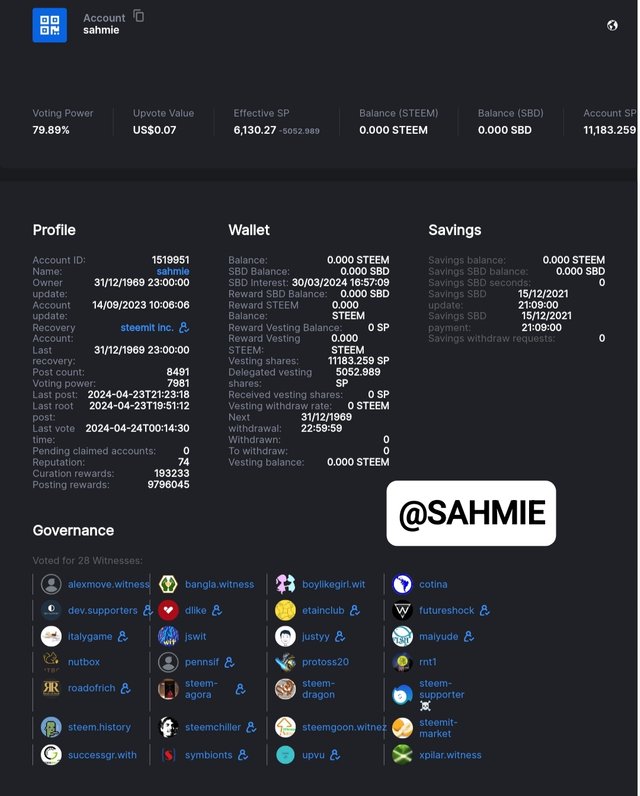 | 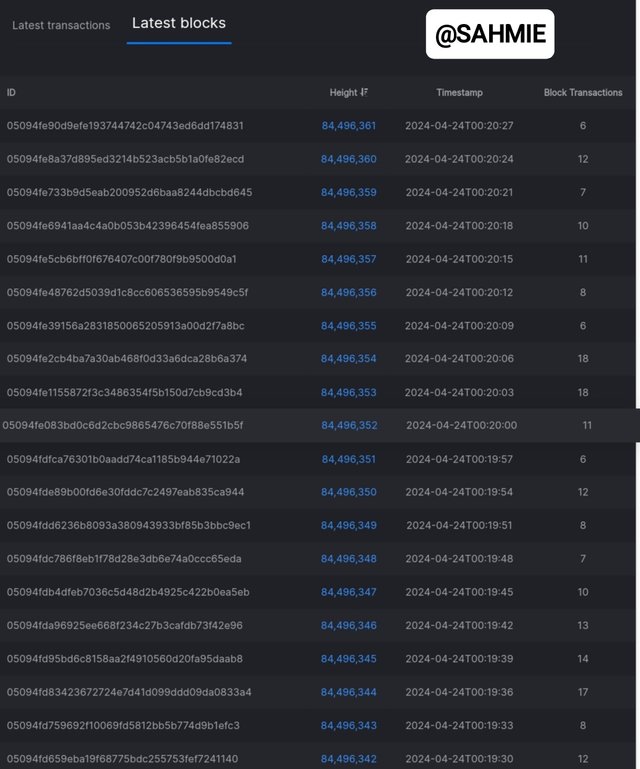 |
|---|
However, for this lesson our focus is on user activities On-chain metrics, hence are some of the main on-chain metrics indicators used to evaluate user activity on the Steem blockchain:
Posts:
This metric measures the number of articles, stories, or updates that a user has shared on Steem, showing how active the user has been in creating content on the platform.
Comments:
This indicator keeps a record of the number of comments or discussions that a user has had on other user's posts and it reflects the level of engagement and interaction a user has within the community.
Upvotes:
Upvotes are an indicator that accounts for the number of thumbs-ups or likes a user gives and/or gets from other users as a means of showing appreciation for content they like. Hence, this metric measures how much a user gives or receives support and recognition for sharing content in the community.
Downvotes
Downvotes which is the opposite of upvotes is an indicator that accounts for the number of thumbs-down or dislikes a user gives and/or gets from other users to show displeasure for content.
Transfers:
This metric keeps records of the number of Steem and SBD transfers between users and/or between a user and exchange platforms, indicating the flow of value and transactions happening on the Steem blockchain.
Followers:
Followers is a metric that counts for the friends a user has made or people who choose to keep up with a user's posts and updates. Therefore, this metric shows how other users are interested in following and staying connected with a particular user.
We can however find all this metrics on Steemworkd under account statistics as shown below.
 |
|---|
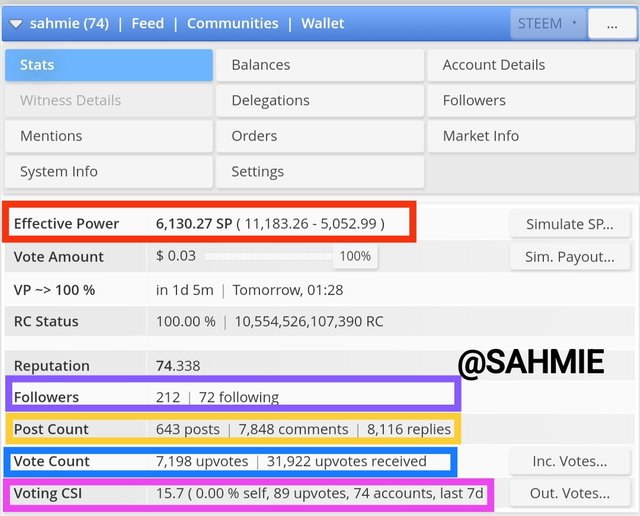 |
|---|
Where the number of users following and I am following is under followers (purple 🟣 rectangle), the number of posts and comments I have made since joining this platform is under posts count (yellow 🟡 rectangle), the number of my users I've voted and those who have voted me is on vote counts (Blue 🔵 rectangle) and lastly the Voting CSI, i.e., the Voting Community Support Index for the last 7 days in Pink.
Therefore, by analyzing all these on-chain metrics, we can get a better understanding of user activity, engagement, and popularity within the Steem community which in turn helps us to know who is active, creating valuable content, and receiving recognition and support from others.
How can On-chain Metrics data from the Steem blockchain be analyzed to understand user engagement trends and community evolution over time? |
|---|
In the previous section, I explained how analyzing these On-chain metrics data from the Steem blockchain can give us insights into user engagement trends and how the community evolves over time, the question now is how can we carry out this analysis?
To explain my thoughts clearly, let's say we have a big jar of colourful candies where each candy represents a different action or interaction on the Steem platform, like posting, commenting, upvoting, and transferring Steem. Hence, by tracking and analyzing the number of candies in the jar over time, we can see patterns and trends in different users' behaviours.
For example, if we notice that the number of candies (posts, upvotes, comments and transfers) in the jar (Steem Blockchain) is increasing steadily, it suggests that more users are actively participating on Steem (putting candies into the jar) and if the number of candies (posts, upvotes, comments and transfers) is decreasing, it means that people are not actively engaging with the Steem platform.
We can also look at the flavours of the candies (or types of actions) to understand what users are most interested in. That is, if we see a lot of green candies (like upvotes), it indicates that certain posts or content are getting a lot of appreciation and support from the community.
In case the candies are confusing to you, let's use an actual example where my analysis will be focused on posts and upvotes.
To analyze On-chain metrics on Steem, let's say we look at the number of posts made each week and we observe that in the first week, there were 100 posts, in the second week, there were 120 posts, and in the third week, there were 110 posts. Hence, from this data, we can see that there was an increase in posts from the first to the second week, but then a slight decrease in the third week.
Next, we examine the number of upvotes received by these posts let's say in the first week, all the posts received a total of 500 upvotes, in the second week, they received 600 upvotes, and in the third week, they received 550 upvotes. This data also shows that there was a consistent increase in upvotes from the first to the second week, but a slight decrease in the third week.
Therefore, by comparing these two metrics, we can observe that in the second week, even though there were more posts, the increase in upvotes was proportionally higher, indicating that the content was more engaging and appreciated by the community. However, in the third week, although the number of posts decreased, the decrease in upvotes was not as significant, suggesting that the quality of the content remained relatively consistent.
This therefore helps us to understand the relationship between posts and upvotes, indicating the level of engagement and appreciation for the content being shared on the Steem blockchain while also providing insights into trends and patterns that can guide content creators and the community in enhancing their engagement strategies.
Therefore by analyzing these trends and patterns in the on-chain metrics data, we can gain a better understanding of how the Steem community is evolving to help us identify popular topics, active users, and areas where engagement might be lacking.
The good aspect of Steem is that every user can have access to these metrics and more using the Steemworld tool, so let me show you this example using my own account.
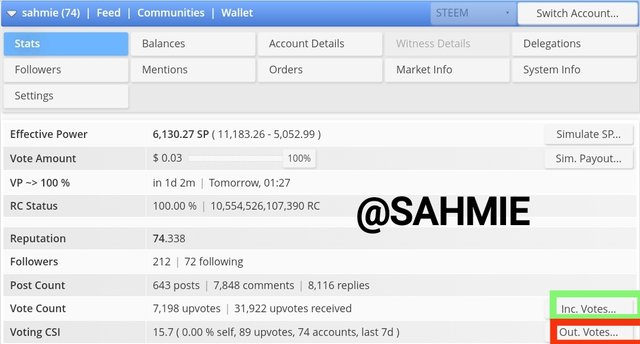 |
|---|
From the above screenshot, when we click on green-marked or red-marked positions will take us to the number of incoming or outgoing votes we have received from other users or given to other users in the last 7 days as shown below.
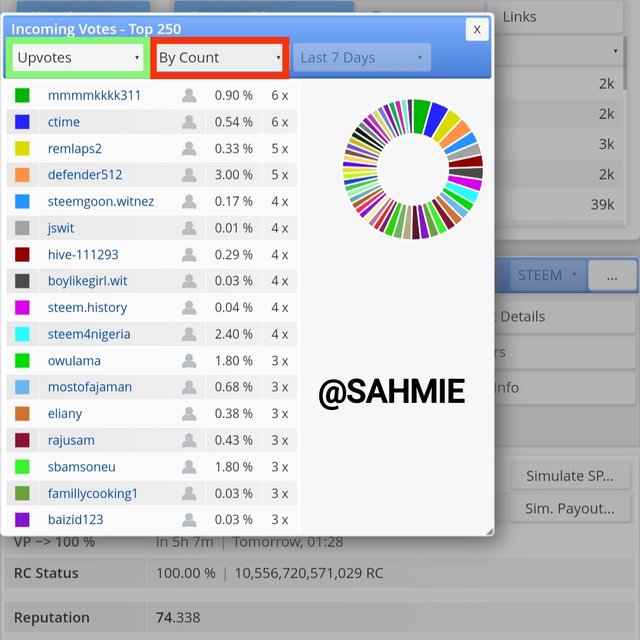 | 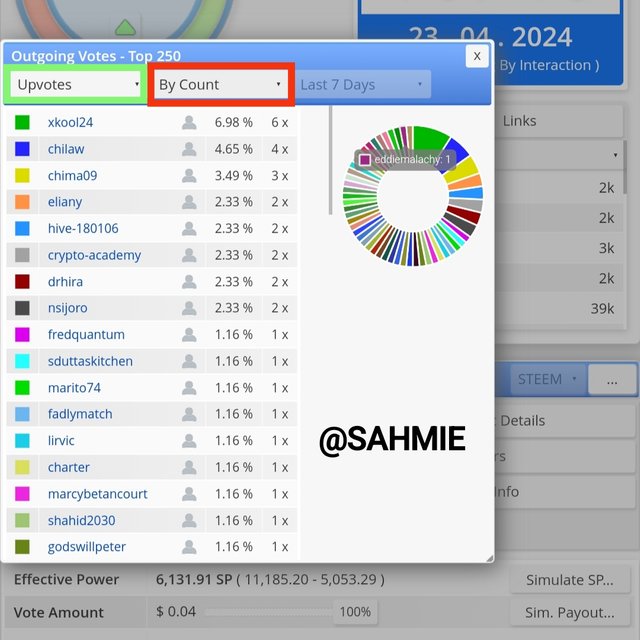 |
|---|
To which we can change to either upvotes or downvotes then by clicking on the red-marked portions, or check the incoming votes by Counts (as in the number of times a user has voted you or you have voted another user in the last 7 days), by Weight (the percentage of their votes or your vote to them) and Amount (how much your vote gives them or their votes gives you).
What are the specific challenges of interpreting On-chain Metrics on the Steem blockchain, considering its unique social structure and incentives? |
|---|
When it comes to interpreting on-chain metrics as an analyst or user on the Steem blockchain, there are some specific challenges one can face, and these challenges may include:
Its Unique Social Structure:
The Steem blockchain being a unique social structure where users can earn rewards for their contributions means that people are motivated to post, comment, and engage with others just to earn the rewards. Therefore users may focus more on just earning the rewards rather than creating valuable content. Therefore when analyzing on-chain metrics, we need to be aware that the number of posts or comments may not always reflect the quality or genuine engagement.
For example, out of my observation as it has come to my notice that because of the Make a Noise program where the top 10 engaging users get a booming vote, I have come across users who spam comments by just copying the exact comment and posting on several other users to increase their engagement points.
This trend is also becoming very popular in the engagement challenges where every user with the highest engagement is expected to win not minding the value of their content thereby making a competition of the highest commenting.
Incentives and Gaming the System:
This is also possible because users can earn rewards, hence creating the possibility for users to game the system by engaging in activities like vote trading or creating multiple accounts (account farming) to boost their rewards leading to distortion of the on-chain metrics and making it challenging to accurately interpret the true level of engagement or popularity of content.
Subjectivity of Metrics:
On-chain metrics can provide valuable insights into community engagement, but then they have limitations. For example, the number of upvotes or comments on a post doesn't always indicate its true quality or impact as different users may have different preferences, and some posts may go unnoticed even if they are valuable. Therefore when analyzing metrics, it is important to consider that they may not always capture the full picture.
Changing Dynamics:
The Steem blockchain is a dynamic ecosystem where users are joining and leaving, trends evolving, and communities forming. Therefore this constant change can make it difficult to establish consistent patterns or trends in the on-chain metrics as what may be popular today may not be the same tomorrow so it's important to regularly update the analysis and be aware of the evolving dynamics.
How can the On-chain Metrics of the Steem blockchain be used to assess the health of its ecosystem, including aspects such as the distribution of voting powers, content diversity, and reward fairness? |
|---|
Analyzing the on-chain metrics related to voting powers, content diversity, and reward fairness can give us insight to how healthy the Steem blockchain ecosystem as a healthy ecosystem would be an ecosystem that promotes decentralized distribution of voting powers, content diversity, and ensure fair rewards for users. But then, how can we determine these factors? Let us examine this accordingly.
Distribution of Voting Powers:
On the Steem blockchain, users are allowed to vote on posts and determine their popularity based on the user's Steem Power. Therefore by analyzing on-chain metrics related to voting, such as the number of votes and the distribution of voting powers which is determined by each user's Steem Power, we can get an idea of how power is distributed among users and their voting patterns i.e., how many votes they receive and give and the people they like to vote on.
Having in mind that a healthy ecosystem would have a more decentralized distribution of voting powers, meaning that each user can vote and influence the content based on their Steem Power.
Content Diversity:
On-chain metrics help us to understand the variety of content being created and shared on the Steem blockchain. So, by looking at metrics such as the number of different topics, the engagement levels on different types of content, and the presence of various perspectives, we can assess whether the ecosystem promotes a wide range of content.
To this effect, I can say this platform supports a wide range of content ranging from sports, health, entrepreneurship, photography, lifestyle, micro images, even animal welfare and many more as all these different categories mentioned above have dedicated communities. When it comes to type, there is also a wide range of topics that are welcomed such as cryptocurrency, promotion, diary games, business reviews, skills showcasing etc.
Reward Fairness:
It is important to ensure that the rewards are distributed fairly among users therefore by examining On-chain metrics such as the distribution of rewards, the average rewards received by different users, and the presence of any anomalies or unfair practices, we can evaluate whether the ecosystem is promoting reward fairness.
To this effect, I can say the reward system of users being rewarded according to the Steem Power in their wallet is fair enough for me as it promotes the habit of investing in the long-term future of the platform by users, and also the fact that the rewards we give are tired to our Steem Power as well. However, it can be harsh on users sometimes when quality content is made and it goes unnoticed may be because the user is not popular or does not have a good amount of Steem Power.
How can Steem blockchain developers utilize On-chain Metrics to enhance platform usability, drive adoption, and address scalability issues while upholding community integrity? |
|---|
Steem blockchain developers can use on-chain metrics to improve platform usability, drive adoption, address scalability, and maintain community integrity in the following ways;
To Enhance Platform Usability:
When developers analyze the on-chain metrics they can gain insights into how users interact with the Steem blockchain platform, hence they can observe users' behaviours, such as the frequency of posting, commenting, and voting, to understand what features are most popular and how users navigate the platform.
This information helps them identify areas for improvement, such as streamlining the user interface, enhancing user experience, and introducing new features that align with user preferences, ultimately leading to a more user-friendly platform that is easier to use and navigate.
In Driving Adoption
On-chain metrics provide valuable information about user engagement and growth on the Steem blockchain which developers can analyze such as the number of active users, the rate of new user registrations, and the level of user retention to assess the platform's adoption rate.
By understanding these metrics, they get to identify strategies to attract more users, such as marketing campaigns, educational resources, and partnerships or they can also leverage on-chain data to identify user needs and preferences, allowing them to tailor the platform to better meet those needs and attract a wider audience.
On Addressing Scalability Issues:
As the Steem blockchain grows, scalability (the speed at which transactions are carried out) becomes crucial and On-chain metrics can help developers identify potential scalability problems by monitoring factors like transaction volume, block size, and network congestion.
Therefore by analyzing these metrics, they can make better-informed decisions about implementing scaling solutions, such as optimizing the network infrastructure, improving consensus algorithms, or exploring layer 2 solutions to ensure that the platform can handle the increasing number of user activities and maintain fast and reliable transaction processing.
On Upholding Community Integrity:
On-chain metrics can assist developers in maintaining community integrity by monitoring metrics related to voting patterns, content quality, and user reputation as the Steem blockchain thrives on its vibrant and engaged community.
By analyzing these metrics, they can identify and address any potential abuse, such as vote manipulation or spamming and they can also use on-chain data to reward genuine contributions, encourage positive interactions, and foster a healthy and inclusive community environment.
CONCLUSION |
In conclusion, when we analyze the on-chain Steem metrics, we are looking at the information and numbers that show how people are using the Steem platform. This can help us understand things like what kind of content people like, how much they engage with it, and how well the platform is doing overall, therefore by studying this data, we can figure out ways to make the community even better and help it grow.
I wish to invite @starrchris, @ngoenyi, and @hamzayousafzai.
Thank You for your Time
NOTE: Always have a smile on your face, as you are never fully dressed without one.

Your post has been successfully curated by @𝐢𝐫𝐚𝐰𝐚𝐧𝐝𝐞𝐝𝐲 at 35%.
Thanks for setting your post to 25% for @null.
We invite you to continue publishing quality content. In this way, you could have the option of being selected in the weekly Top of our curation team.
Upvoted. Thank You for sending some of your rewards to @null. It will make Steem stronger.
Thank you, friend!


I'm @steem.history, who is steem witness.
Thank you for witnessvoting for me.
please click it!
(Go to https://steemit.com/~witnesses and type fbslo at the bottom of the page)
The weight is reduced because of the lack of Voting Power. If you vote for me as a witness, you can get my little vote.
Saludos cordiales estimado amigo sahmie, un placer para mi saludarte y leer tu participación en este reto.
Te felicito por tener una excelente y profunda comprensión de las métricas Onchain de nuestro ecosistema Steem, el cual posee una complejidad única para estudiar estas métricas debido a sus constante cambio.
Te deseo un feliz, bonito y bendecido día.
Thank you so much for your kind words. It is great to hear that you appreciate my understanding of the On-chain metrics in the Steem ecosystem. These metrics helps us understand what's going on in the Steem Blockchain but then can sometimes be quite complex to study because they are constantly changing. I hope you have a happy, beautiful, and blessed day as well.
@sahmie Great breakdown of how on chain metrics function on the Steem blockchain! Your explanation makes it easy to understand the significance of each metric from posts to upvotes and transfers. Its impressive how these metrics offer insights into user engagement and community dynamics. Good luck with your analysis and I appreciate the detailed insights you have shared!
Thank you so much for your kind words. I'm glad that my explanation of the on-chain metrics on the Steem blockchain was helpful and easy to understand. These metrics, like posts, upvotes, and transfers, give us important information about how engaged users are and how the community is doing. Once again thank you for your time and support.
Las métricas son el historial de nuestro desempeño dentro de la plataforma. En ella podemos ver una radiografía no solo propia sino de cualquier steemians, ya que es un libro abierto.
Esta transparencia es una característica formidable de la blockchain con la cual podemos darnos una idea de su salud así como sus debilidades.
Conocer el comportamiento de las grandes ballenas y curadores dice mucho de la aplicación cierta de los criterios a la hora repartir las recompensas, un punto ciertamente cuestionable y debatible, pues todos queremos participar de la piscina de curación.
¡Saludos, mucha suerte y éxitos!
Greetings @casv,
I love your analogy of x-ray. It's true that these metrics are like a history of our performance on the platform as they show us how well we're doing and we can also see how other Steem users are doing. It's like an open book that gives us transparency.
Understanding these metrics therefore helps us know how the platform is doing and where it can improve and we can also learn about the behaviour of influential users and how rewards are distributed. Thank you for your wonderful feedback, support and time. I really appreciate them all.
!Saludos amigo, mucha suerte!
Upvoted! Thank you for supporting witness @jswit.
I think by analyzing on-chain metrics we can get valuable insights into user behavior and community dynamics. It's essential for understanding the working of the platform and recognizing contributors who enrich the community. It is an art of data analysis or understanding the language of data to interpret the practical aspects and impact thereof.
Identifying evolving trends and areas for improvement through on-chain metrics analysis is crucial for adapting and fostering a vibrant community of Steem . The advantage is that it allows for targeted interventions to enhance user experience and boost engagement.
So the concluding remarks would be; understanding how people use the Steem platform is super important. On-chain metrics help us see what users like and how well the platform is doing. This info is crucial for making the community better and more fun for everyone.
All the best.
Thank you so much for taking the time to read through my post on the topic at hand and leaving such heartfelt feedback. Your kind words and support means a lot to me and I truly appreciate your support.